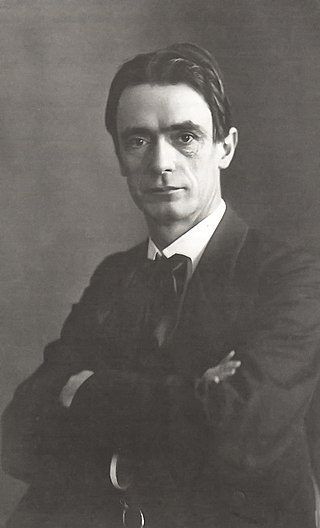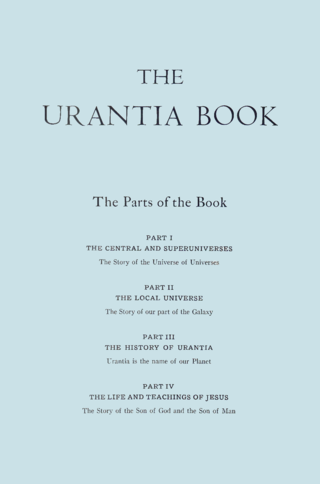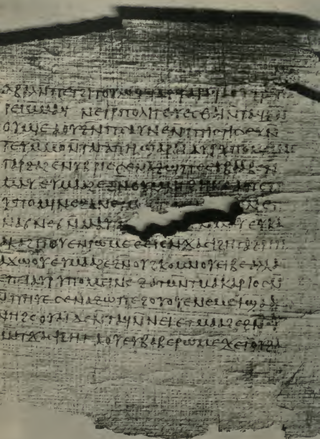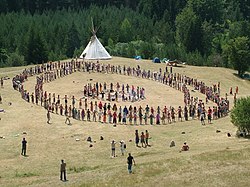
Gnosticism is a collection of religious ideas and systems that coalesced in the late 1st century AD among Jewish and early Christian sects. These various groups emphasized personal spiritual knowledge (gnosis) above the proto-orthodox teachings, traditions, and authority of religious institutions.

Irenaeus was a Greek bishop noted for his role in guiding and expanding Christian communities in the southern regions of present-day France and, more widely, for the development of Christian theology by combating heterodox or Gnostic interpretations of Scripture as heresy and defining proto-orthodoxy. Originating from Smyrna, he had seen and heard the preaching of Polycarp, who in turn was said to have heard John the Evangelist, and thus was the last-known living connection with the Apostles.

Rudolf Joseph Lorenz Steiner was an Austrian occultist, social reformer, architect, esotericist, and claimed clairvoyant. Steiner gained initial recognition at the end of the nineteenth century as a literary critic and published works including The Philosophy of Freedom. At the beginning of the twentieth century he founded an esoteric spiritual movement, anthroposophy, with roots in German idealist philosophy and theosophy. His teachings are influenced by Christian Gnosticism. Many of his ideas are pseudoscientific. He was also prone to pseudohistory.

The Urantia Book is a spiritual, philosophical, and religious book that originated in Chicago, Illinois, United States sometime between 1924 and 1955, claimed, when first published, to have been written by celestial beings. The actual authorship remains a matter of debate, though it has been noted that it appears to have plagiarized multiple sources, without attribution. It received various degrees of interest ranging from praise to criticism for its religious and science-related content, its unusual length, and the unusual names and origins of the authors named within the book.

In Islam, Jesus is believed to be the penultimate prophet and messenger of God and the Messiah sent to guide the Children of Israel with a book called the Injīl.
Valentinus was the best known and, for a time, most successful early Christian Gnostic theologian. He founded his school in Rome. According to Tertullian, Valentinus was a candidate for bishop but started his own group when another was chosen.

The Infancy Gospel of Thomas is an apocrypha gospel about the childhood of Jesus. The scholarly consensus dates it to the mid-to-late second century. The Infancy Gospel of Thomas is generally considered to be Gnostic in origin because of references in letters to a "Gospel of Thomas", but it is unclear whether those letters refer to the Infancy Gospel or the Gospel of Thomas, a sayings gospel discovered near Nag Hammadi, Egypt in 1945.
Helen Cohn Schucman was an American clinical psychologist and research psychologist. She was a professor of medical psychology at Columbia University in New York from 1958 until her retirement in 1976. Schucman is best known for having "scribed" with the help of colleague William Thetford the book A Course in Miracles, the contents of which she claimed had been given to her by an inner voice she identified as Jesus. However, at her request, her role as its "writer" was not revealed to the general public until after her death.

Elaine Pagels, née Hiesey, is an American historian of religion. She is the Harrington Spear Paine Professor of Religion at Princeton University. Pagels has conducted extensive research into early Christianity and Gnosticism.

The Gospel of Mary is a non-canonical text discovered in 1896 in a fifth-century papyrus codex written in Sahidic Coptic. This Berlin Codex was purchased in Cairo by German diplomat Carl Reinhardt.

The Apocryphon of John, also called the Secret Book of John or the Secret Revelation of John, is a 2nd-century Sethian Gnostic Christian pseudepigraphical text attributed to John the Apostle. It is one of the texts addressed by Irenaeus in his Against Heresies, placing its composition before 180 AD. It is presented as describing Jesus appearing and giving secret knowledge (gnosis) to his disciple John. The author describes it as having occurred after Jesus had "gone back to the place from which he came".

The Acts of Andrew, is a Christian apocryphal work describing acts and miracles of Andrew the Apostle. It is alluded to in a Coptic 3rd-century work titled the Manichaean Psalm Book, so it must have been composed prior to that century. By the 4th century, the stories told in the book were considered apocryphal, and the book was relegated to the New Testament apocrypha.

The Epistle of the Apostles is a work of New Testament apocrypha. Despite its name, it is more a gospel or an apocalypse than an epistle. The work takes the form of an open letter purportedly from the remaining eleven apostles describing key events of the life of Jesus, followed by a dialogue between the resurrected Jesus and the apostles where Jesus reveals apocalyptic secrets of reality and the future. It is 51 chapters long. The epistle was likely written in the 2nd century CE in Koine Greek, but was lost for many centuries. A partial Coptic language manuscript was discovered in 1895, a more complete Ethiopic language manuscript was published in 1913, and a full Coptic-Ethiopic-German edition was published in 1919.

Endeavor Academy, founded in 1992 as the New Christian Church of Full Endeavor, was a community of students of Charles Buell Anderson, which focused primarily on the teachings found in the book A Course in Miracles. Anderson's teachings also incorporate elements from the New Testament, and from other various spiritual and religious leaders. The community lists itself as an "international school of enlightenment", and also as a seminary.
William Thetford was an American psychologist, medical psychologist and professor. He is best known for his collaboration with Helen Schucman in typing the original manuscript and being on the editing team for A Course in Miracles (ACIM), a self-study curriculum in spiritual psychology. He died in 1988, aged 65, in Tiburon, California, after having made his involvement with the ACIM material and its study the most central focus of his life.
The Da Vinci Code, a popular suspense novel by Dan Brown, generated criticism and controversy after its publication in 2003. Many of the complaints centered on the book's speculations and misrepresentations of core aspects of Christianity and the history of the Catholic Church. Additional criticisms were directed toward the book's inaccurate descriptions of European art, history, architecture, and geography.

A Return to Love: Reflections on the Principles of A Course in Miracles (1992) is the first book by Marianne Williamson, and concerns the 1976 book A Course in Miracles by Helen Schucman. A Return to Love was a New York Times Best seller.

Benedict Joseph Groeschel, C.F.R. was an American Franciscan friar, Catholic priest, retreat master, author, psychologist, activist, and television host. He hosted the television talk program Sunday Night Prime on the Eternal Word Television Network, as well as several serial religious specials.

Traditionally in Christianity, orthodoxy and heresy have been viewed in relation to the "orthodoxy" as an authentic lineage of tradition. Other forms of Christianity were viewed as deviant streams of thought and therefore "heterodox", or heretical. This view was challenged by the publication of Walter Bauer's Rechtgläubigkeit und Ketzerei im ältesten Christentum in 1934. Bauer endeavored to rethink Early Christianity historically, independent from the views of the current church. He stated that the 2nd-century church was very diverse and included many "heretical" groups that had an equal claim to apostolic tradition. Bauer interpreted the struggle between the orthodox and heterodox to be the "mainstream" Church of Rome struggling to attain dominance. He presented Edessa and Egypt as places where the "orthodoxy" of Rome had little influence during the 2nd century. As he saw it, the theological thought of the "Orient" at the time would later be labeled "heresy". The response by modern scholars has been mixed. Some scholars clearly support Bauer's conclusions and others express concerns about his "attacking [of] orthodox sources with inquisitional zeal and exploiting to a nearly absurd extent the argument from silence." However, modern scholars have critiqued and updated Bauer's model.

Richard Smoley is an author and philosopher focusing on the world's mystical and esoteric teachings, particularly those of Western civilization.















